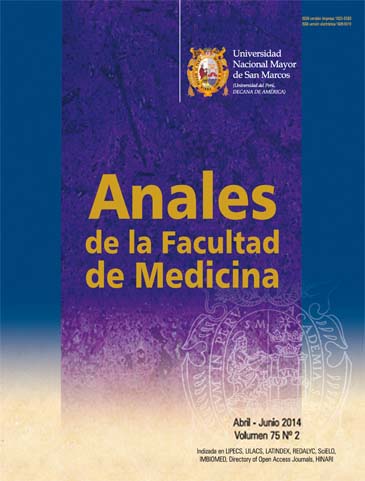Metabolically healthy obese patients
DOI:
https://doi.org/10.15381/anales.v75i2.8386Keywords:
Metabolically normal obese, obesity, cardiovascular riskAbstract
Introduction: Obesity is a public health problem that tends to increase and compromises the health of people. Objectives: To determine the prevalence of metabolically normal obese (OMN) subjects depending on the presence of cardiovascular risk factors in an adult population showing obesity and morbid obesity. Design: Observational, descriptive and cross-section study. Setting: Department of Endocrinology, Hospital Dos de Mayo, Lima, Peru. Participants: Obese adults without metabolic diseases. Interventions: the study was conducted during the period between April 2009 and May 2010 in all adults consulting for obesity and who declared not having type 2 diabetes mellitus, arterial hypertension or dyslipidemia. Weight, height and waist circumference (WC) were obtained, and body mass index (BMI) was calculated. Those who had 30 kg/m2 or more were included in the study. Insulin, glucose and lipid profile were determined. Metabolic syndrome was determined through measurement of glucose, HDL-C, triglycerides and WC. Insulin resistance (IR) was diagnosed through glucose and insulin resistance homeostasis model assessment (HOMA-IR). Two groups were distinguished: obese with BMI of 30 to 39.9 kg/m2, and obese with BMI 40 kg/m2 and more. Statistical analysis was performed using student t test and chi -square with a 95% confidence interval and a significance level of < 0.05. Main outcome measures: Average and standard deviation variables. Prevalence of OMN and OMnotN. Results: From the 158 subjects, 91.2 % were female The OMN and OMnotN groups showed statistically significant difference in weight, height, WC, insulin and HOMA-IR. OMN prevalence was 7% in all obese and 7.3 and 6.4% in the BMI groups (Wildman criteria), while it was 13%, 15.5 and 2.1 % respectively by Meiggs criteria. Conclusions: The study showed the presence of a reduced number of obese subjects considered OMN by the criteria used.Downloads
Published
2014-06-16
Issue
Section
Trabajos originales
License
Copyright (c) 2014 Jaime Pajuelo R., Hugo Arbañil H., José Sánchez Gonzales, Dante Gamarra G., Harold Torres A., Rosa Pando, Rosa Aguero Z.

This work is licensed under a Creative Commons Attribution-NonCommercial-ShareAlike 4.0 International License.
Those authors who have publications with this magazine accept the following terms:
- Authors will retain their copyrights and guarantee the journal the right of first publication of their work, which will be simultaneously subject to Creative Commons Attribution License that allows third parties to share the work as long as its author and its first publication this magazine are indicated.
- Authors may adopt other non-exclusive licensing agreements for the distribution of the version of the published work (eg, deposit it in an institutional electronic file or publish it in a monographic volume) provided that the initial publication in this magazine is indicated.
- Authors are allowed and recommended to disseminate their work over the Internet (eg: in institutional telematic archives or on their website) before and during the submission process, which It can produce interesting exchanges and increase quotes from the published work. (See El efecto del acceso abierto ).
How to Cite
1.
Pajuelo R. J, Arbañil H. H, Sánchez Gonzales J, Gamarra G. D, Torres A. H, Pando R, et al. Metabolically healthy obese patients. An Fac med [Internet]. 2014 Jun. 16 [cited 2025 Jun. 2];75(2):113-8. Available from: https://revistasinvestigacion.unmsm.edu.pe/index.php/anales/article/view/8386



